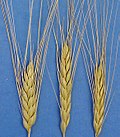Emmer
Emmer is a type of wheat that is one of the earliest cultivated forms of wheat, alongside einkorn. It is a tetraploid wheat, having two sets of chromosomes, which gives it a higher protein content than other types of wheat. Emmer is used in a variety of foods, including breads, pastas, and cereals.
History[edit]
Emmer wheat was first cultivated in the Near East around 10,000 years ago, during the Neolithic Revolution. It was one of the first crops to be domesticated, and was a staple food in ancient civilizations such as Egypt and Rome. Emmer wheat was eventually replaced by higher-yielding types of wheat, but it has seen a resurgence in popularity in recent years due to its nutritional benefits and unique flavor.
Cultivation[edit]
Emmer wheat is a hardy crop that can be grown in a variety of climates. It is typically planted in the fall and harvested in the summer. Emmer wheat prefers well-drained soil and requires moderate amounts of water. It is resistant to many common wheat diseases, making it a reliable crop for farmers.
Nutritional Benefits[edit]
Emmer wheat is high in protein, fiber, and minerals such as magnesium and zinc. It is also a good source of B vitamins, which are essential for energy metabolism. Emmer wheat has a low glycemic index, which means it can help regulate blood sugar levels. This makes it a good choice for people with diabetes or those trying to lose weight.
Uses[edit]
Emmer wheat can be ground into flour and used in a variety of baked goods, including breads, pastas, and cereals. It can also be cooked whole and used in salads or as a side dish. Emmer wheat has a nutty flavor and a chewy texture, which adds depth and complexity to dishes.
See Also[edit]
|
|
|
Emmer[edit]
-
Emmer
-
Emmer
-
Polyploid wheat origins
-
Flora of Israel - Triticum turgidum subsp. dicoccoides
-
Composite sickles for cereal harvesting at 23,000-years-old Ohalo II, Israel
-
Triticum turgidum subsp. dicoccum var. atratum
-
Trilla del trigo en el Antiguo Egipto
-
Castel del Piano - Minestra di farro
Ad. Transform your life with W8MD's Budget GLP-1 injections from $75


W8MD offers a medical weight loss program to lose weight in Philadelphia. Our physician-supervised medical weight loss provides:
- Weight loss injections in NYC (generic and brand names):
- Zepbound / Mounjaro, Wegovy / Ozempic, Saxenda
- Most insurances accepted or discounted self-pay rates. We will obtain insurance prior authorizations if needed.
- Generic GLP1 weight loss injections from $75 for the starting dose.
- Also offer prescription weight loss medications including Phentermine, Qsymia, Diethylpropion, Contrave etc.
NYC weight loss doctor appointmentsNYC weight loss doctor appointments
Start your NYC weight loss journey today at our NYC medical weight loss and Philadelphia medical weight loss clinics.
- Call 718-946-5500 to lose weight in NYC or for medical weight loss in Philadelphia 215-676-2334.
- Tags:NYC medical weight loss, Philadelphia lose weight Zepbound NYC, Budget GLP1 weight loss injections, Wegovy Philadelphia, Wegovy NYC, Philadelphia medical weight loss, Brookly weight loss and Wegovy NYC
|
WikiMD's Wellness Encyclopedia |
| Let Food Be Thy Medicine Medicine Thy Food - Hippocrates |
Medical Disclaimer: WikiMD is not a substitute for professional medical advice. The information on WikiMD is provided as an information resource only, may be incorrect, outdated or misleading, and is not to be used or relied on for any diagnostic or treatment purposes. Please consult your health care provider before making any healthcare decisions or for guidance about a specific medical condition. WikiMD expressly disclaims responsibility, and shall have no liability, for any damages, loss, injury, or liability whatsoever suffered as a result of your reliance on the information contained in this site. By visiting this site you agree to the foregoing terms and conditions, which may from time to time be changed or supplemented by WikiMD. If you do not agree to the foregoing terms and conditions, you should not enter or use this site. See full disclaimer.
Credits:Most images are courtesy of Wikimedia commons, and templates, categories Wikipedia, licensed under CC BY SA or similar.
Translate this page: - East Asian
中文,
日本,
한국어,
South Asian
हिन्दी,
தமிழ்,
తెలుగు,
Urdu,
ಕನ್ನಡ,
Southeast Asian
Indonesian,
Vietnamese,
Thai,
မြန်မာဘာသာ,
বাংলা
European
español,
Deutsch,
français,
Greek,
português do Brasil,
polski,
română,
русский,
Nederlands,
norsk,
svenska,
suomi,
Italian
Middle Eastern & African
عربى,
Turkish,
Persian,
Hebrew,
Afrikaans,
isiZulu,
Kiswahili,
Other
Bulgarian,
Hungarian,
Czech,
Swedish,
മലയാളം,
मराठी,
ਪੰਜਾਬੀ,
ગુજરાતી,
Portuguese,
Ukrainian










